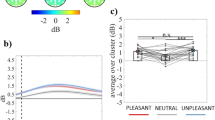Abstract
This study examined the effects of electroencephalographic-(EEG-) driven photic stimulation on a case of depressive disorder, as measured by a psychometric test of mood states, EEG parameters, and several autonomic indices. The EEG-driven photic stimulation enhances the alpha rhythm of brain waves using photic signals, the brightness of which is modulated by a subject's own alpha rhythm. The patient was a 37-year-old businessman, who was treated for depression with medication during the 13 months prior to his first visit to our hospital. He underwent two sets of inpatient treatment sessions, comprising first 16 and then 18 treatment sessions. The treatments brought about the following changes: an improvement in general mood state, alpha rhythm increase, cardiac parasympathetic suppression, and increased skin conductance level. In addition, significant correlations between alpha rhythm increase and cardiac parasympathetic suppression or cardiac sympathetic predominance were observed with each inpatient treatment. Significant correlations between alpha rhythm increase, cardiac parasympathetic suppression, or cardiac sympathetic predominance and the improvement of general mood state were also observed. Thus, from these observations, it was concluded that the alpha enhancement induced by EEG-driven photic stimulation produced an improvement in the patient's depressive symptomatology connected with cardiac parasympathetic suppression and sympathetic predominance.
Similar content being viewed by others
References
Adrian, E. D., & Matthews, B. H. C. (1934). Berger rhythm: Potential changes from the occipital lobes of man.Brain, 57, 355–385.
Berger, H. (1969). On the electroencephalogram of man.Electroencephalography and Clinical Neurophysiology, Suppl. 28, 37–73.
bond, A. J., James, D. C., & Lader, M. H. (1974). Physiological and psychological measures in anxious patients.Psychological Medicine, 4, 364–373.
Chijiiwa, M., Yasushi, M., Saito, S., tsutsui, S., Tsuboi, K., & Makino, M. (1992). Application of photic feedback system to psychosomatic medicine.Japanese Journal of Biofeedback Research, 19, 49–56.
Freeman, A. (1989).The practice of cognitive therapy. Tokyo: Seiwa Shoten Publishers (in Japanese).
Hare, J. F., Timmons, B. H., Roberts, J. R., & Burman, A. S. (1982). EEG alpha-biofeedback training: An experimental technique for the management of anxiety.Journal of Medical Engineering and Technology, 6, 19–24.
Hardt, J. V., & Kamiya, J. (1978). Anxiety change through electroencephalographic alpha feedback seen only in high anxiety participants.Science, 201(7), 79–81.
Hayano, J., Sakakibara, Y., Yamada, A., Yamada, M., Mukai, S., Fujinami, T., Yokoyama, K., Watanabe, Y., & Takata, K. (1991). Accuracy of assessment of cardiac vagal tone by heart rate variability in normal subjects.The American Journal of Cardiology, 67(2) 199–204.
Kamei, T., Yasushi, M., Kumano, H., Suematsu, H., & Masumura, S. (1993, August).Mental relaxation induced by photic feedback system. Paper presented at the 1993 World Congress of World Federation for Mental Health, Tokyo.
Kumano, H., Horie, H., Kuboki, T., Suematsu, H., Yasushi, M., Saitou, S., Chijiiwa, M., Fukui, T., & Sakano, Y. (1993). A single-case study of the application of the photic feedback system to depressive neurosis.Shinshin-Igaku, 33, 651–658 (English abstract).
Malmo, R. B. (1959). Activation: A neuropsychological dimension.Psychological Review, 66, 367–386.
Moss, E. M., Davidson, R. J., & Saron, C. (1985). Cross-cultural differences in hemisphericity: EEG asymmetry discriminates between Japanese and Westerners.Neuropsychologia, 23, 131–135.
MPI Study Group (1969).A new personality test: The Maudsley Personality Inventory. Tokyo: Seishin-Shobou (in Japanese).
Pagani, M., Lombardi, F., Guzzetti, S., Rimoldi, O., Furlan, R., Pizzinelli, P., Sandrone, G., Malfatto, G., Dell'orto, S., Piccaluga, E., Turiel, M., Baselli, G., Cerutti, S., & Malliani, A. (1986). Power spectral analysis of heart rate and arterial pressure variabilities as a marker of sympatho-vagal interaction in man and conscious dog.Circulation Research, 59, 178–193.
Papp, N., & Ktonas, P. (1977). Critical evaluation of complex demodulation techniques for the quantification of bioelectrical activity.Biomedical Sciences Instrumentation, 13, 135–143.
Sakano, Y., Fukui, T., Kumano, H., Horie, H., Kawahara, K., Yamamoto, H., Nomura, S., & Suematsu, H. (1994). Development and validation of a new mood inventory.Shinshin-Igaku, 34, 629–636 (English abstract).
Sasaki, T., Ideshita, H., Yamanaka, Y., Oda, T., Shigekawa, R., Kikumoto O., & Shiwa, S. (1988). A study on the clinical effects of bio-feedback therapy.Shinshin-Igaku, 28, 609–616.
Tomarken, A. J., Davidson, R. J., Wheeler, R. E., & Kinney, L. (1992). Psychometric properties of resting anterior EEG asymmetry: Temporal stability and internal consistency.Psychophysiology, 29, 576–592.
Tryon, W. W. (1982). A simplified time-series analysis for evaluating treatment interventions.Journal of Applied Behavior Analysis, 15, 423–429.
Walter, D. O. (1968). The method of complex demodulation.Electroencephalography and clinical Neurophysiology, Suppl. 27, 53–57.
Yasushi, M., Saito, S., & Chijiiwa, M. (1992). Photic drive response by brain wave feedback.Japanese Journal of Biofeedback Research, 19, 41–48.
Author information
Authors and Affiliations
Rights and permissions
About this article
Cite this article
Kumano, H., Horie, H., Shidara, T. et al. Treatment of a depressive disorder patient with EEG-driven photic stimulation. Biofeedback and Self-Regulation 21, 323–334 (1996). https://doi.org/10.1007/BF02214432
Issue Date:
DOI: https://doi.org/10.1007/BF02214432




